
Plague Quarantine Page Menu: 1 2 3 4 5 6 7 8 9 10 11 12 13 14 15 Next>>
Golden Age of Piracy Maritime Quarantine For Plague, Page 13
The Mediterranean Lazarettos - Trafaria, Portugal
Portugal had only one 'permanent' lazaretto and that does not appear to have been anywhere near as large or well-organized as the other structures discussed. Historian Laurinda Abreu explains that during the sixteenth through eighteenth centuries, Portugal "activated all the public health institutions and regulations
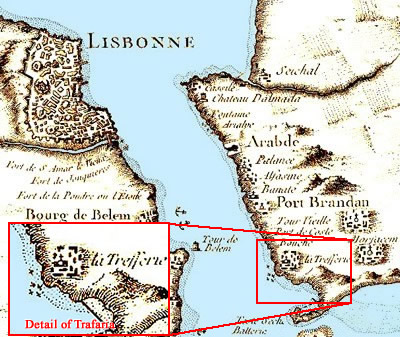
Cartographer: Jacques Nicolas Bellin
Plan du Port de Lisbonne, With Detail of Trafaria Showing Structures (1756)
(the health boards, the Lisbon Health Authority, the Health Statute of 1526 and the Trafaria lazaretto) in the manner first developed by the Italian states"1 when it felt threatened by the bubonic plague. If the plague broke out, the Portuguese crown set up temporary local health boards in the places affected; the only permanent health board was in Lisbon and the only permanent lazaretto was located in Trafaria.
Trafaria was a windswept beach with sparse vegetation which was "dominated by rural agricultural, farms and convents"2, located on the southern shore of the entrance into the Tagus estuary, about seven miles away from the city. Here, Cardinal Infante Henrique (future King of Portugal) was instructed to found a lazaretto on August 7, 1565 at the behest of King Sebastian as "a place for the quarantine of the crews of ships from affected areas with plague"3 on land which originally belonged to Gaspar da Rua.4
Very little is known about the original structure, although some descriptions of the lazaretto are found in Lisbon Archivist Eduardo Freire de Oliveira's recounting of the history of Lisbon based on the contemporary records. Olivera refers to it as "old small houses that were the old lazareto or disinfection station, originally ordered built during the regency of Cardinal Henrique"5. A letter written in 1709 requesting the lazaretto be renovated describes the lazaretto at the site as being "a small, very bad warehouse being almost ruined, with no buildings for offices, or for the officers [of the lazaretto] to lodge"6. This letter also explains that the buildings were 'falling to the ground', apparently due to lack of care.
In the years between its construction and the discussion about renovating the lazaretto building, other structures had been built which were used by the lazaretto. In 1678, the
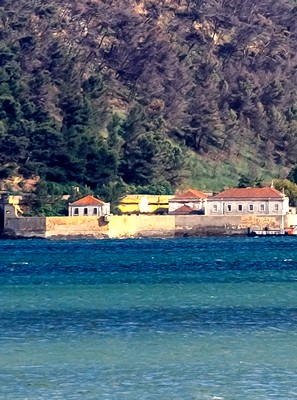
Photo: Wiki User Rúdisicyon
Forte de Nossa Senhora da Saúde da Trafaria Today
(It would have looked quite different during the 17th/18th century.)
Health Officers of the Lisbon Chamber had the Chapel of Our Lady of Health built next to what were described as 'the Lazaretto Warehouses of the Port of Belém', located in Trafaria. (This is the only structure which can be readily identified in the above map - it's the building with a cross on top of it.) Five years later, King Pedro II of Portugal had a fort built to complement the defense of the capital on the south bank of the Tagus bar which was called Forte de Nossa Senhora da Saúde da Trafaria (Fort of Our Lady of Health of Trafaria). The fort was ordered to be used in service of the lazaretto in 1695.7 "The fort of Trafaria, from the time of Dom Pedro II, was used to store the goods in quarantine. The disinfection service, which consisted of the airing of goods, was carried out by the health offices of the port of Belem."8
The point of the 1709 letter was to officially complain that goods put into the lazaretto to air were being ruined during quarantine because of the poor conditions of the structures there. Whether this refers only to the warehouse structures built before the fort was employed or included the fort as well is not clear. The letter also says that four or five houses had been "built by some people, inconsiderately, so close to the wall of said Lazareto, that they can not fail to communicate with those who will profit from the cloths"9. It asked that the houses be removed and the wall of the lazaretto widened, probably to help prevent people from spoiling the quarantine and to protect the goods being aired. King João V of Portugal thus "ordered that the lazaretto enclosure be enlarged by decree of November 19, 1711"10 without consulting the senate of health. Nothing happened as a result of this decree, so it was renewed on December 9th, 1713. The official site of the monuments of Portugal mentions that both the chapel and the main buildings of lazaretto were refurbished in 1725.11
As with the lazaretto itself, little is known the type or nature of the modifications to the lazaretto. Unlike France and Italy, whose records contain a great deal of information about their lazarettos, including plans of them, precious little seems information to have been unearthed from the Portuguese records by modern authors. Unlike nearly every other major Mediterranean lazaretto, there are no images of the lazaretto at Trafaria and it does not appear in any of the maps printed while it was in operation.12 Based on the above bits of information
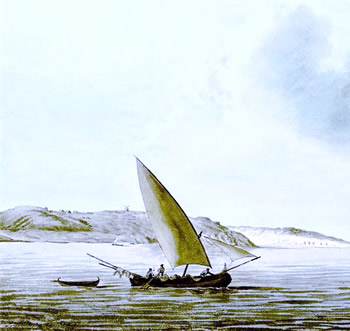
Artist: John Clevely the Younger
Boat on the River Tagus in Front of Trafaria (1775)
and the 1695 instructions for quarantine, Regimenta da provimento da saude para o porto de Belem, it appears that human quarantine was served shipboard while merchandise was taken to the lazaretto warehouses to be aired. No instructions are given for handling people in quarantine in the lazaretto itself.13 Note the protected bay in front of Trafaria on the map at the top of this section. It would have been an excellent, remote location for anchoring ships in quarantine.
Two sailors accounts from around the golden age of piracy mention the processes of quarantine and pratique at Trafaria. The first is mostly incidental. Navy chaplain Henry Teonge says that when HMS Assistance arrived in Lisbon in September of 1676, "the Lieutenant of the Castle, and the Prattick Master, [came] with a message from the Prince Regent and the Chamber to command us to be gone out of their port within twenty-four hours, or else we must look to be fired out [chased out with cannon]"14. Other than the fact that it was the man in charge of pratique who delivered the message, it is not clear that this had anything to do with quarantine or pratique and may even have been animosity towards the English.
The second example is definitely related to quarantine. Merchant sailor Nathaniel Uring, who was bringing logwood into the port in early 1713, explained that many of his men were "sick on my Arrival at Lisbon, the Officers of Health obliged me to lie [in] Quarantine Twenty Five Days"15.From this description, they remained aboard during their quarantine. He also notes that no one from the city came aboard until after the quarantine period had been completed.
1 Laurinda Abreu, “Epidemics quarantine and state control in Portugal 1750-1805”, Mediterranean Quarantines, 1750-1914, 2018, p. 234; 2 Larissa dos Santos Malty, Participação Social Decorrente da Implantação de Megaprojetos em Pequenas Comunidades - o caso da Trafaria, estuário do rio Tejo, Doctoral Thesis, February, 2017, p. 104 & 106, translated by the author; 3 Malty, p. 106 4 See Malty, p. 106 & Eduardo Freire de Oliveira & Câmara Municipal de Lisboa, Elementos para a historia do municipio de Lisboa, Tomo X, 1899, p. 570-1, translated by the author; 5 Freire de Oliveira, p. 571; 6 Freire de Oliveira, p. 490; 7 Teresa Ferreira, “Forte de Nossa Senhora da Saúde da Trafaria / Presídio Naval da Trafaria / Capela de Nossa Senhora da Saúde”, momentos.gov.pt, gathered 6/5/19, translated by author; 8 Alberto Pimentel, A Extremadura Portugueza, Vol 2, 1908, p. 253-4, translated by the author; 9 Freire de Oliveira, p. 491; 10 Freire de Oliveira, p. 570; 11 Ferreira, “Forte de Nossa Senhora da Saúde da Trafaria...”, gathered 6/5/19; For a Selection of Maps dated 1561-1883, Many Showing the Relevant Part of the Tagus, see this blog; 13 See Freire de Oliveira, p. 422-35, particularly p. 427-30; 14 Henry Teonge, The Diary of Henry Teonge, Chaplain on Board H.M.’s Ships Assistance, Bristol, and Royal Oak, 1675-1679, 1825, p. 212;15 Nathaniel Uring, A history of the voyages and travels of Capt. Nathaniel Uring, 1928, p. 179
Mediterranean Pratique - Sailors in Spanish and Portuguese Mediterranean Ports
The sailors' accounts mention pratique in the Mediterranean in association with several Spanish locations and one particularly relevant one in a Portuguese port. None of these mention a lazaretto, but they are still relevant to the quarantine process during the Golden Age of Piracy.
Sailor Samuel Atkins twice mentions efforts to obtain pratique at the port of Alicante, Spain. The first was in February of 1681, when he and the captain of his ship, the navy frigate Crown, went ashore to 'demand' pratique,
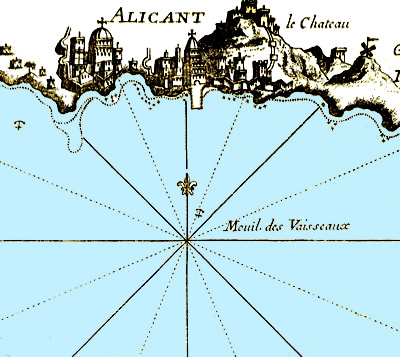
Cartographer: Joseph Roux
Alicante, Spain, From Receuil Des Principaux Plans des Ports, Plate 6 (1764)
but they were told they couldn't get it until the next morning because the officials able to grant it were not available. So they anchored by the Mole after talking with the local English merchants. Returning the next day to seek pratique, the English found that the officials there
insisted upon such termes to give it us with, as could by noe meanes be granted, without bringing innovation into ye ffleet, and in the Factory there, which neither hee nor ye Captaine would admitt, upon which after delivering our letters for ye place, and those for England to ye merchants, and receiving some fresh meat and Sallating [vegetables] wee took our leaves, and went on board.1
HMS Crown was again at Alicante in December bringing a captured prize ship, the Red Lyon, with them. The presence of the prize ship "hindered our having prattick [pratique], notwithstanding which we went ordinarily ashoare into ye towne in our owne boats"2. This offhand reference to going ashore freely on a previous visit is curious given that Atkins only mentions them being in Alicante in the site before this second visit. He may have been referring to other English vessels.
Alicante did not have a lazaretto when Atkins visited it. Professor Eduord Bueno notes that in Spain, "port cities developed a set of practices that went through the monitoring of the maritime trade flow... over time, the control of vessels arriving at the port [of Alicante] was generalized in order to certify that there was no risk of contagion, which was known as the 'health protection'."3 In order to facilitate this, the designated official collected a ship's bill of health when it arrived and took an oath from the ship's captain about the current health of the crew. When they decided quarantine was required, they sent the ship to 'known quarantines'.
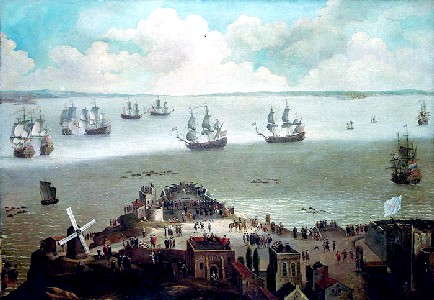
Artist: Daniel Schellinks - Cadiz Harbor, National Maritime Museum London (1675)
Two sailors mention pratique at Cadiz, Spain. The first is navy chaplain Henry Teonge who was aboard the HMS Assistance when she anchored in the Bay of Bulls off Cadiz in August, 1676. He says, "Here wee are ...denyed prattick: they will receive nothing
from us, nor let us have anything from them. So wee shall have no wine."4
The second mention of pratique at Cadiz comes from French priest Jean-Baptiste Labat's return to Cadiz in 1706 after living for twelve years in the Caribbean. He describes the process of receiving pratique there, something already discussed in detail in the section Quarantine at Mediterranean Lazarettos - Cheating. In summary, an inspector first came aboard their boat to make sure everyone aboard was healthy. Seeing they were, an 'officer' (almost certainly a health official of some kind) followed him, telling them they were not allowed ashore. Four other officials were left behind (probably guardians) to monitor the passengers and crew. The jovial Labat goes on to explain that these men complained about the 'lack of hospitality' of the ship and its crew. So they bribed them which seems to have cleared everything up.5 (This might explain why the Assistance failed to receive pratique there.)
Cadiz actually did have a lazaretto on the nearby Isla de León which was established in 1722 in response to the outbreak of plague at Marseille.6 Medical historian Esteban Rodríguez-Ocaña explains that this was "a temporary lazaretto, built of boards, on the beach of Puntal or Puntales, in 1722, by order of the Supreme Board of Health"6. The Board of Health rented a house equipped with warehouses and surrounded by a large amount of land which belonged to Pedro Infante de Olivares. However, this was abandoned in 1728.7
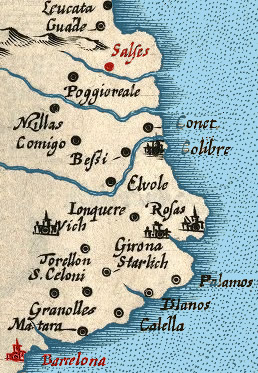
Cartographer: Gerhard Mercator
Barcelona and Saflue/Salfes/Sant Feliu de Guíxols,
From the Map 'Aragonia et Catelonia' (1607)
However, this lazaretto had nothing to do with the two accounts previously described. Rather, it appears that this area was governed by the same set of 'practices' which Bueno says were in place at Alicante.
While gunner aboard merchant ship 'Marey Gould' in 1675, Edward Barlow says that they left Barcelona sailing north-east and stopped at a location he calls 'Saflue' near Cape de Gofrieda' (most likely Sant Feliu de Guíxols about 250 miles north-east of Barcelona). He describes it as a small port where local vessels stopped for supplies. Barlow explains, "At first they would not let us come ashore or give us any ‘prodick’ [pratique], but at last knowing what we came for and for to stay no longer, they let us have some wine, buying thirty gallons for twelve shillings, good wholesome wine to drink."8 So the sailors were not granted pratique; the local merchants simply sold them wine. This would have been prohibited if they were in quarantine or deemed unsafe. This again calls to the use of the 'practices' discussed by Bueno. The port was far to small to rate a lazaretto.
The last example of Spanish maritime pratique in comes from a sailor visiting the island of Grand Canary off the western coast of what is now Morocco on the African continent, which was under the control of Spain. Sailor Francis Rogers reported that when the merchant vessel Arabia arrived at the island in 1702, "The Spaniards made us to wait almost an hour in our boat, before they would give us product [pratique], that is permit us to land, we not having a bill of health from England. At last by the means of the Master of the English ship, who used [was?] there and came lately from England, satisfying them that we were not sickly there [in England], we were suffered to come on shore"9. This is quite a loose concept of what constituted valid pratique, even less strict than what was employed in mainland Spain. Of course, the Canary Islands were quite far removed from the mother country.
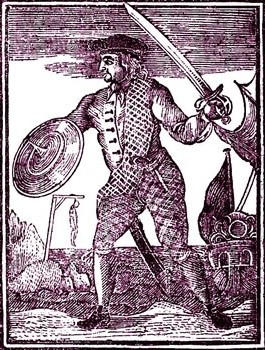
John Gow, From A General History of the Pyrates,
p. 112 (1725)
The last example of pratique in the Mediterranean is the only one which directly concerns a golden age pirate. John Gow found himself in need of both water and wine and decided to head for Madeira, a Portuguese-held island. They waited three or four days for a vessel to either arrive at or leave the island so that they could take and plunder her. However, no ship came or left during that time. Due to their ship's 'Posture' (the way they sailed and the look of their ship), the people of Madeira recognized them as pirates.
Realizing that he was seen as a threat at Madeira, Gow decided to sail to Porto Santo, another Portuguese island about 25 miles north-east. The Ordinary's Account explains, "here putting up British Colours [a British flag to fool those on shore about the ship's nationality], they sent their [small] Boat ashoar with Captain Somervill’s Bill of Health [they had previously captured John Somerville's vessel, plundered it of everything of value to them including some herring and salmon and sunk it], and [brought] a Present to the Governour of three Barrels of Salmon"10. The Governor of Porto Santo granted them pratique and decided to pay the ship a visit with several of his 'principle People'. He was well received by Gow until the pirates turned on them and made them prisoners. The pirates then announced that they would be released when those on land provided them with the food and beverage they needed. This was subsequently done so the pirates released the governor and his men.
1 Samuel Atkins, "A Sailor's Journal", Colburn's United Service Magazine, Part 1, 1854, p. 205; 2 Atkins, "A Sailor's Journal", Part 3, p. 544; 3 Eduardo Bueno, "Resguardo de la Salud, Comercio Marítimo y Centralismo Borbónico: El Caso del Puerto de Alicante en el Siglo XVIII", Comercio Y Cultura en La Edad Moderna, 2015, p. 1230, translated by the author; 4 Henry Teonge, The Diary of Henry Teonge, Chaplain on Board H.M.’s Ships Assistance, Bristol, and Royal Oak, 1675-1679, 1825, p. 208; 5 Pere Jean-Baptiste Labat, The Memoirs of Pére Labat 1693-1705, 1970, p. 261; 6 Esteban Rodríguez-Ocaña, "La cuestión del lazareto marítimo permanente en la España del siglo XVIII, de Cádiz a Mahón", Asclepio, 1988, vol. 40, n. 1, p. 266; 7 For those interested, an overview of this lazaretto Including several diagrams of the site can be found on this website; 8 Edward Barlow, Barlow’s Journal of his Life at Sea in King’s Ships, East and West Indiamen & Other Merchantman From 1659 to 1703, p. 269; 9 Francis Rogers, from Bruce S. Ingram's book Three Sea Journals of Stuart Times, 1936, p. 146; 10 Select and Impartial Accounts of the Lives, Behavior, and Dying-Words Of the most Remarkable Convicts, Vol. II, 1745, p. 219

